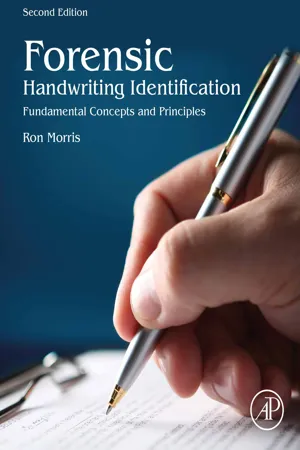
- 320 pages
- English
- ePUB (mobile friendly)
- Available on iOS & Android
About this book
Forensic Handwriting Identification: Fundamental Concepts and Principles teaches the law enforcement and legal communities the major principles involved in handwriting and hand-printing analysis as applied to many types of investigations, including fraud, homicide, suicide, drug trafficking/clandestine labs, sexual offenses, threats and extortion, blackmail, arson, bombings, and theft. Lawyers and investigators will learn how to interpret an examiner's report, the significance of various handwriting opinions and the influencing factors which must be considered.- Reviews basic concepts that affect a person's writing, demonstrates how to obtain handwriting specimens and evidence, and provides the appropriate ASTM and SWIGDOC standards and procedures- Ideally suited for forensic science and legal professionals, investigators working with document examiners, and law enforcement students and professionals- Includes model specimen handwriting forms
Frequently asked questions
- Essential is ideal for learners and professionals who enjoy exploring a wide range of subjects. Access the Essential Library with 800,000+ trusted titles and best-sellers across business, personal growth, and the humanities. Includes unlimited reading time and Standard Read Aloud voice.
- Complete: Perfect for advanced learners and researchers needing full, unrestricted access. Unlock 1.4M+ books across hundreds of subjects, including academic and specialized titles. The Complete Plan also includes advanced features like Premium Read Aloud and Research Assistant.
Please note we cannot support devices running on iOS 13 and Android 7 or earlier. Learn more about using the app.
Information
Table of contents
- Cover image
- Title page
- Table of Contents
- Copyright
- Acknowledgments
- Introduction
- Chapter 1: The physiology of writing
- Chapter 2: Handwriting systems
- Chapter 3: Class characteristics
- Chapter 4: Individuality and individual characteristics
- Chapter 5: Characteristics, qualities, and features of writing
- Chapter 6: Relative speed of writing
- Chapter 7: Ratios—Relative relationships
- Chapter 8: Beginning, connecting, and ending strokes
- Chapter 9: Writing instruments and their influence
- Chapter 10: Some general observations about handwriting identification
- Chapter 11: The process of comparison
- Chapter 12: Is it fabricated?
- Chapter 13: Abnormal/disguised writing
- Chapter 14: Obtaining handwriting samples
- Chapter 15: Submitting a questioned document case to the laboratory
- Chapter 16: What does the examiner's report say?
- Index